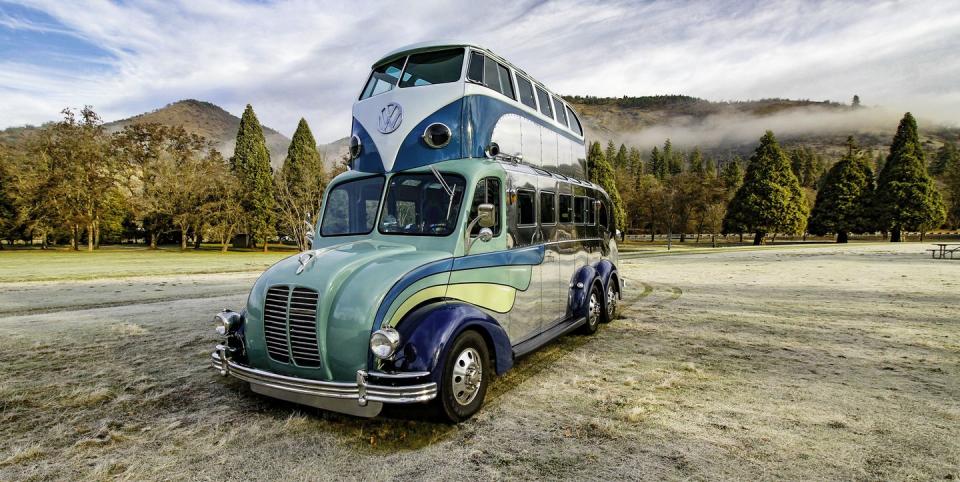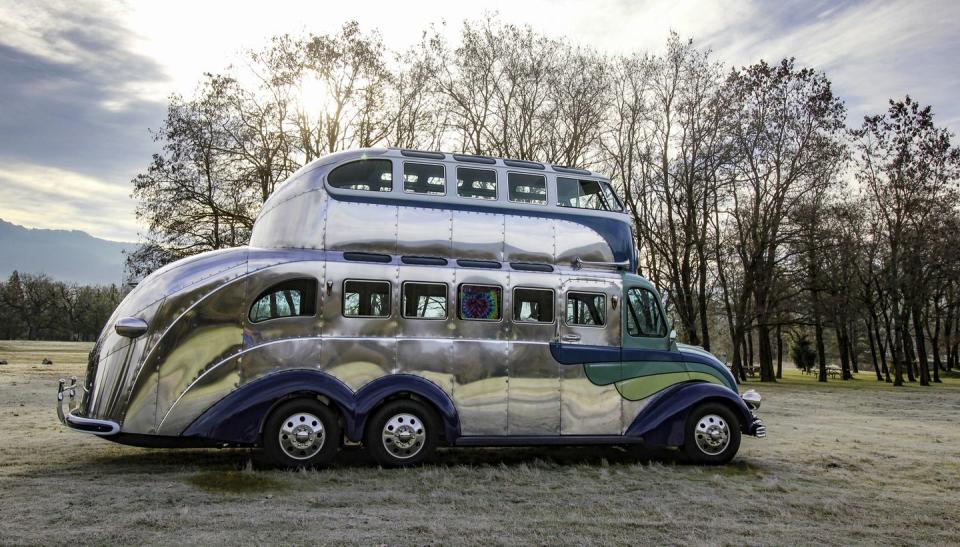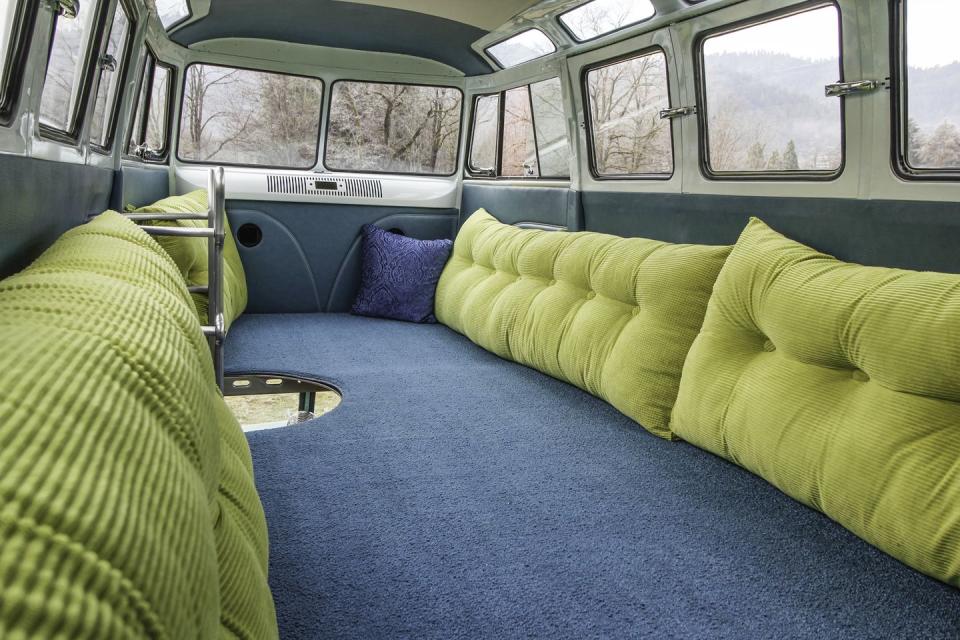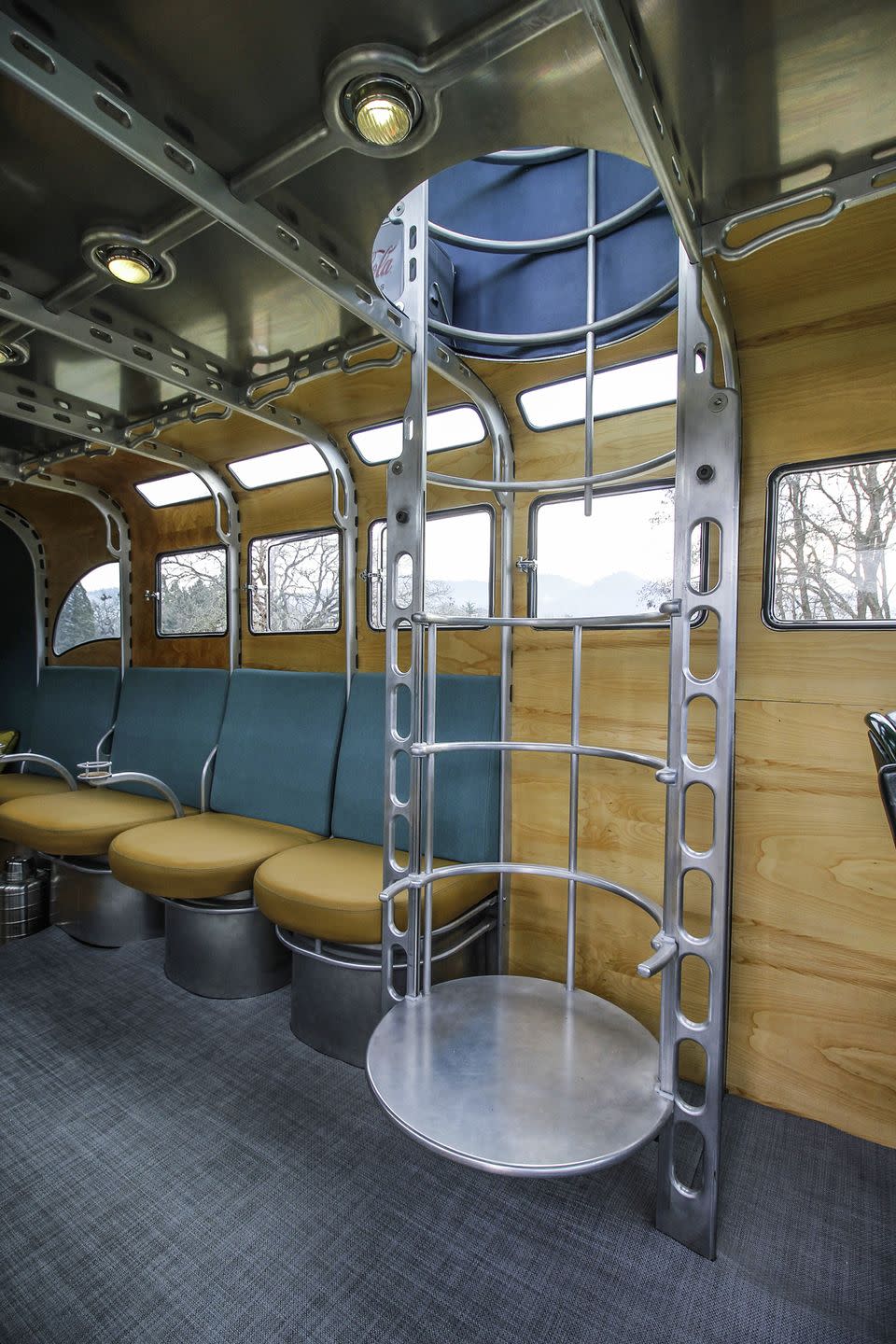Check Out This Magic Double-Decker Deco Bus

So, here's Randy Grubb's "Magic Bus." It's a mix of milk truck, Volkswagen Microbus, GMC Motorhome, hand-formed aluminum, and sci-fi all frappéd in an art-deco blender with some pastel paint. For those who remember a time when Volkswagen vans weren't collector items, it's a throwback to the hippy contraptions of the psychedelic era when cast-off school buses would be expanded into double-decker crash pads by welding VW shells atop the roofs. Think 1968, when The Who first released "Magic Bus."
Grubb's bus is also an evolution of his Decoliner, which C/D featured in the February 2013 issue. It takes many of the ideas built into that split-level road vessel and refines them for specific duty. Specific because, while Decoliner was built to Grubb's whims, the Magic Bus was commissioned by one of Grubb's patrons. And that language is precise because Grubb views himself as an artist and vehicles as his medium. Suitably, then, the Magic Bus is making its official public debut at the 70th annual Grand National Roadster Show January 25-27 at the Pomona, California, Fairplex. Formerly known as the Oakland Roadster Show, it's the celebration of hot-rod craftsmanship where the top award is called America's Most Beautiful Roadster, or AMBR.
"For the chassis, I went back to the same '70s GMC motorhome I used on the Decoliner," Grubb explains about the Magic Bus's basic engineering. "And for the same reasons. That front-wheel-drive platform allows us to stack double high and still have plenty of room for everything."

The GMC Motorhome, produced between 1973 and 1978, is itself an ingenious classic of the mobile-house species. Using drivetrain bits from the then current Oldsmobile Toronado and an air suspension that includes inline dual rear tires along each flank, GM was able to engineer a practically flat-floored coach that was significantly closer to the ground and sleeker-looking than its competition. So, the Magic Bus is powered by an easygoing 455-cubic-inch (7.5 liter) Oldsmobile V-8 that feeds into GM's TH425 three-speed automatic transaxle. Nothing exotic, and, while Grubb has rebuilt all the components, it's likely that the Magic Bus's engine is making close to the 250 horsepower it was rated at when installed in the 1973 Toronado.
Working in his Grants Pass, Oregon, shop, Grubb started this time with a 1947 Divco milk truck. "It was the only other iconic, art deco piece that lent itself well to being sister to the Decoliner," Grubb says comparing the Divco's bulldog nose to that of the Decoliner, which was swiped from a 1950 White 3000 cab-over.
"As soon as I saw the Divco close to the chassis, I saw that it was going to be a little bit too narrow. And stacking the VW bus on top, I thought it was going to be too narrow and tall. So to balance the thing, the first thing I did was widen the Divco milk truck."
At first glance, the Divco nose seems practically unchanged. But in fact, Grubb blew it apart and widened it a total of eight inches. That meant sectioning the hood and front grille into 30 different pieces, adding new sheet steel, reshaping the grille, and welding it all back together. The nose is now hinged at the front and tilts open as one piece. Each of the two panes of windshield is four inches wider than stock. The fenders are new aluminum pieces hand-formed by Grubb.
One subtle change is that Grubb has moved the headlights off the Divco's nose and replaced them with large combination light and turn signal units off a Peterbilt semi. The front bumper center is from the leading edge of a 1949 Plymouth, while the bumper ends are from the tail of the same car. It's dressed out with over-riders from a 1957 Corvette.
"We bought a 1962 VW," Grubb continues. "It started life as an 11-window, and I bought the kit to convert the roof into the 23-window, adding the top lights and the sunroof. But the giant sunroof is even gianter than it should be. It's actually 18 inches longer than a regular Kombi sunroof. Just because I wanted it bigger."

With the Divco nose in place and the Microbus suspended over it, Grubb built a structure using aluminum girders cut on a water-jet table. Spaced 24 inches apart, these run down the sides of the lower body and integrate into the standard structure of the VW. With that structure in place, Grubb skinned the bus with subtly voluptuous sheet aluminum. The torpedo tail shape of the VW was formed around the slope of Beetle rear side windows. And yes, the standard VW headlights are in working condition.
Then rear fenders are formed from scratch by Grubb and, he says, shaped with inspiration from Marilyn Monroe's cleavage. "It's a very unusual fender treatment," Grubb asserts. "And I think it's successful."
To get from the lower deck to the upper deck, Grubb built a one-person elevator using hidden cables and a winch usually used on ATVs. Grubb claims that its design is based on that of one aboard the fictional Jupiter 2 spacecraft as seen on the original Lost In Space TV series.
Since Grubb's client is planning to use the Magic Bus for Wine Country excursions out of San Francisco, and temperatures in the Napa Valley can easily exceed 100 degrees in the summer, there's a big, limousine-spec air conditioning unit in the front of the VW portion to keep the upstairs cool. Another oversize A/C unit is at the back of the VW, and it blows downstairs.

There are no seats upstairs in the Magic Bus. Instead it's lined with pillows, so riders up there can carouse, cavort, and cuddle in fully prone style. Also, unlike the Decoliner which could be driven from its upper deck, the Magic Bus must be driven from downstairs.
In the main cabin, there's seating for a dozen or so friendly people and a classic Coca-Cola cooler to keep them refreshed. In the tail there's a sort of conversation pit where people can get together to enjoy each other's company.
Hippy-dippy lunacy that it is, that Magic Bus makes perfect sense for its intended purpose of taking members from San Francisco's "The Battery" social club on communal excursions. It's nudging up against nearly sensible in that sense, more practical than many Grubb creations.
As part of the Blastolene vehicular art collective, Grubb has built up a portfolio of vehicles ranging from Jay Leno's Tank Car and a Peterbilt-based street rod known as Piss'd Off Pete to, well, the Decoliner and Magic Bus. "I like what I call 'mechanical-ocity,' " concludes Grubb. "I want my pieces to be interesting to everybody at every level."
You Might Also Like

 Yahoo Autos
Yahoo Autos 